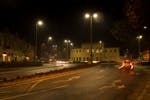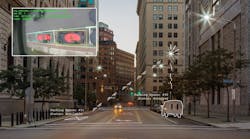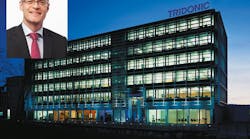This article was published in the February 2012 issue of LEDs Magazine.
View the Table of Contents and download the PDF file of the complete February 2012 issue.
+++++
In late December, the European Commission (EC) published a Green Paper on LED- and OLED-based solid-state lighting (SSL) entitled “Lighting the future: Accelerating the deployment of innovative lighting technologies.” The document proposes a number of new Europe-wide policy initiatives that are intended to accelerate the deployment of SSL in European Union (EU) member states. The Green Paper also encourages public debate in Europe involving all interested parties, which are listed as research and business stakeholders, governments, civil society communities and citizens.
The Green Paper’s publication initiated a public consultation period, which ends on February 29, 2012. The EC is seeking the views of all interested individuals and organizations on the relevant issues involved, and will collect replies to specific questions that are set out in the Green Paper. Links to the Green Paper and the consultation documents can be found at www.ledsmagazine.com/news/8/12/19.
SSL in Europe
The EC believes that, while Europe’s lighting industry is both “large and world class,” SSL market uptake is slow in Europe. The Green Paper says that the LED-based SSL accounted for 6.2% of the overall lighting market in Europe in 2010. However, several studies indicate that SSL will account for more than 70% of Europe’s general-lighting market by 2020. This assumes that various market barriers can be removed to enable SSL to deliver its full potential.
The EC also says that SSL-related research, innovation and cooperative activities are fragmented in Europe. In this respect, Europe compares poorly with the USA and various countries in Asia. The situation indicates a need for immediate action at the European level.
First, the Green Paper addresses policies targeting European users (consumers, professional users and public procurers) that will help to overcome existing challenges and promote wider market uptake. This includes raising awareness of, and demonstrating, the benefits of SSL, as well as proposing initiatives to prevent early market failure.
On the supply side, the Green Paper proposes policies that “foster the competitiveness and global leadership” of the European lighting industry. This will, says the EC, contribute to the creation of growth and jobs.
Challenges and policies
Several specific challenges are indentified for SSL: products are expensive; users are unfamiliar with this new technology and need to develop trust in its use; the technology is subject to rapid innovation; and there is a lack of standards.
A number of policy instruments related to SSL – some voluntary, some mandatory – are already in place in Europe. Several of these were described by Paolo Bertoldi of the EC’s Joint Research Centre at last October’s Strategies in Light Europe conference.
Perhaps best known is the Ecodesign Directive which has set minimum performance requirements for non-directional lamps. This has already resulted in the phase-out of inefficient 60W-and-above incandescent lamps. The EC intends to adopt a new Ecodesign regulation that will cover directional light sources (e.g. reflector lamps), setting minimum functionality requirements.
The EC is also revising the Energy Labelling regulation for light sources, and intends to include LEDs and all kinds of directional and professional lamps. Energy labels are intended to allow end-users to choose more-efficient products by providing standard product information on energy consumption. Revised Ecolabel criteria are also under consideration; Ecolabel is a voluntary scheme to promote products with good environmental performance. A number of other instruments also apply to SSL, including the Low-Voltage Directive, and the directives on Restriction of Hazardous Substances (RoHS) and on Waste Electrical and Electronic Equipment (WEEE).
Of course, for these various policy instruments to be effective, they need to be effectively policed. As stated in the Green Paper, EU member states and the lighting industry need to ensure that SSL products sold in Europe conform to EU legislation on performance and safety requirements. An effective market-surveillance scheme is seen as a prerequisite for the uptake of high-quality LED products within the EU market.
Also, the Green Paper invites lighting stakeholders and/or consumer associations to organize awareness campaigns that help to increase user awareness of SSL products. Part of this activity is the need to make sure that various technical properties are explained properly on the product package, so that consumers can make meaningful comparisons.
Another potential barrier to SSL is related to concerns about biological safety, often described as “the blue-light hazard.” For more on this subject, see our series of articles concluding on page 63 of this issue. The EC says that it will “continue to monitor developments” regarding potential effects of LED lighting technology on consumers’ health.
SSL in cities
The Green Paper identifies lack of awareness or lack of incentives as reasons why cities are reluctant to use SSL in large-scale outdoor-lighting deployments (see Fig. 1). The high upfront investment cost often clashes with tight city budgets that run on an annual basis, and this creates difficulties even when the overall lifetime cost of SSL is significantly lower. Issues are also caused by the lack of standards with which to develop proper specifications, and the lack of trusted quality-certification schemes.
One option could be to use Green Public Procurement (GPP), an EU-level voluntary scheme whereby public authorities seek to procure goods and services with a reduced environmental impact. Many member states have adopted their own approaches at the national level for supporting “green” procurement.
Financial schemes also exist that could be used by cities to finance feasibility studies for investment in energy-related projects. Examples include European Local Energy Assistance (ELENA) and the European Energy Efficiency Fund (EEE-F). These and other financing mechanisms could be used, says the EC, to plan large-scale SSL deployments. The EC is also suggesting that a dedicated task force should be set up by representatives from cities, the lighting industry and others; this could discuss public-private partnerships, financing schemes, and mechanisms to share information and best practices.
Pilot projects that demonstrate the benefits of SSL and smart-control systems are recognized as being very important. In fact, two or three large-scale demonstration projects, funded by the Competitiveness and Innovation Framework Programme (CIP), are due to be announced soon, following a call that closed in mid 2011 (www.ledsmagazine.com/news/8/2/5).
SSL in buildings
One specific challenge of deploying SSL in private buildings is described by the EC as the “landlord-tenant conflict.” This is the mismatch of interests between the building’s owner, who pays the upfront cost of the lighting, and the building’s user, who usually pays the running costs. The Green Paper highlights the need for financial and other incentives to encourage users to buy and install SSL products. One model could be energy-performance contracting, where a service company makes an investment to install an SSL system, and then receives a return based on the achieved energy savings. The EC also suggests that member states should provide incentives to individual consumers to replace their current lighting with SSL.
In terms of public buildings, GPP can be used by public authorities to support the wider deployment of energy-efficient lighting. Another relevant proposal is for a Directive on Energy Efficiency, which will require public authorities to purchase products (including lighting products) that belong to the highest energy-efficiency class. There will also be obligations for utilities to implement energy-saving measures for end-users, and for the public sector to renovate publicly-owned buildings.
Meanwhile, the Energy Performance of Buildings Directive (EPBD) requires member states to set minimum energy-performance requirements for buildings.
Public consultation
The public consultation invites participants to answer a series of questions (12 in total) included within the Green Paper. These include:
• What can member states do to reinforce the market surveillance of product performance and safety in the area of SSL lighting products?
• Which specific measures would you propose for accelerating SSL uptake? • Which other actions could be taken by industry to reinforce sustainable SSL manufacturing capacity in Europe?



![An installer uses a cell phone to configure a connected lighting system in a Next Generation Lighting Systems (NGLS) living lab. [Photo credit: Image courtesy of Pacific Northwest National Laboratory (PNNL) and NGLS.] An installer uses a cell phone to configure a connected lighting system in a Next Generation Lighting Systems (NGLS) living lab. [Photo credit: Image courtesy of Pacific Northwest National Laboratory (PNNL) and NGLS.]](https://img.ledsmagazine.com/files/base/ebm/leds/image/2020/06/NGLS_Photo_2.5ed693de53fa2.png?auto=format,compress&fit=crop&q=45&h=139&height=139&w=250&width=250)


